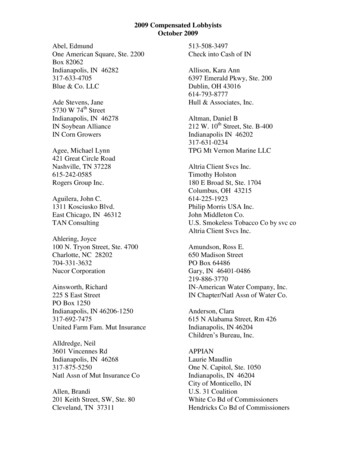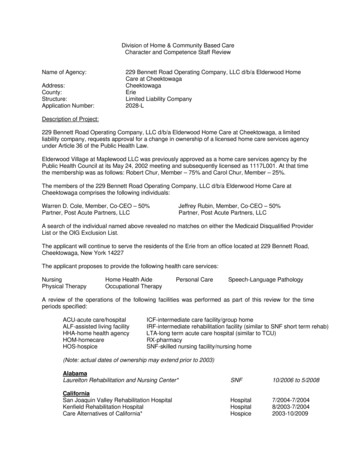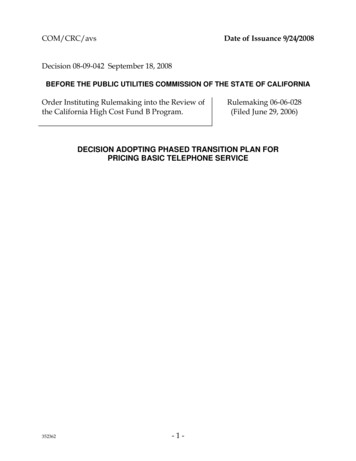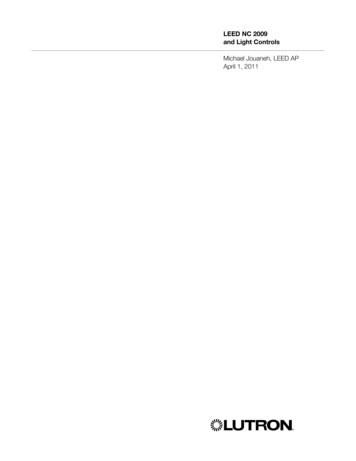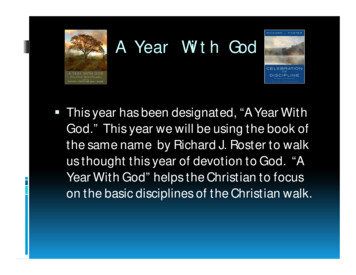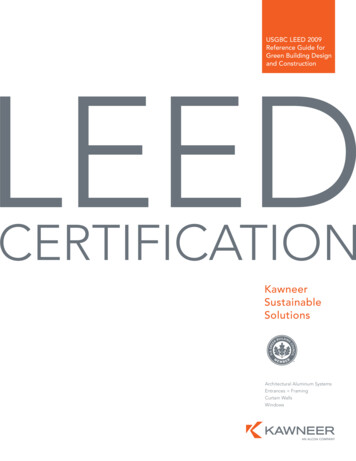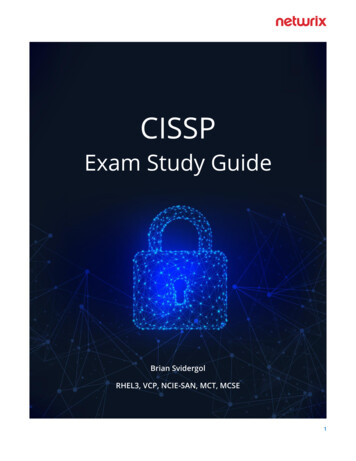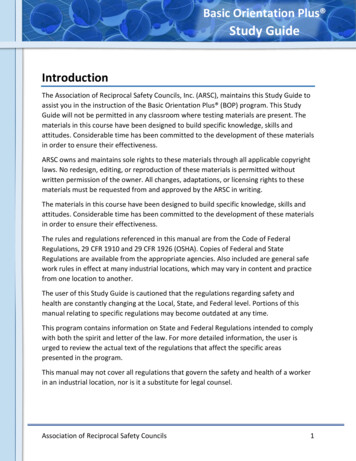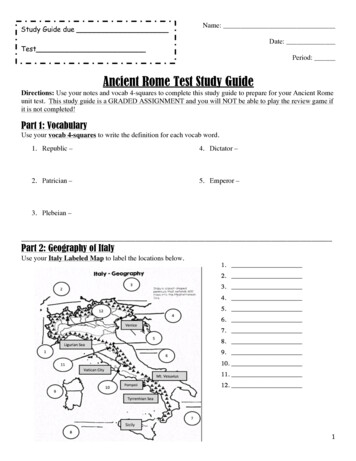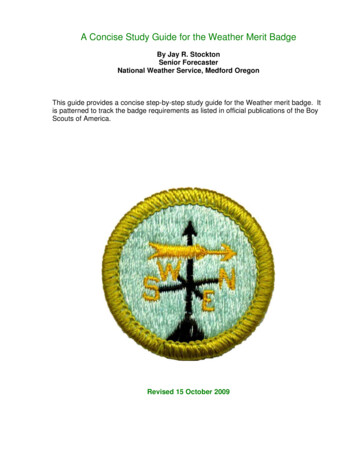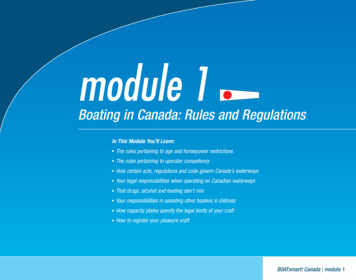
Transcription
module 1Boating in Canada: Rules and RegulationsIn This Module You’ll Learn:The rules pertaining to age and horsepower restrictionsThe rules pertaining to operator competencyHow certain acts, regulations and code govern Canada’s waterwaysYour legal responsibilities when operating on Canadian waterwaysThat drugs, alcohol and boating don’t mixYour responsibilities in assisting other boaters in distressHow capacity plates specify the legal limits of your craftHow to register your pleasure craftBOATsmart! Canada module 1
IntroductionBoating in CanadaIts Everyone’s ResponsibilityOperator Training and CertificationRecreational boating is a pastime that many of us enjoy.As a boater in Canada, you are expected to understandOn April 1, 1999 the Canadian Coast Guard enactedIn fact, each year over 8 million boaters enjoy Canada’sand obey the rules and regulations that apply onthe Competency of Operators Pleasure Craft Regulations.waterways. Unfortunately, not all survive. The CanadianCanadian waterways. By using common sense andThese regulations phase in mandatory operatorRed Cross and the Lifesaving Society of Canada reportoperating your craft in safe and responsible manner,competency standards over a ten year period andapproximately 200 boating fatalities per year. Sadly,you’ll protect yourself, your passengers and yourrequire that operators obtain a Pleasure Craftmost of these deaths are preventable. In addition, overfellow boaters.Operator Card. This system affects operators of6000 unreported non-fatal incidents occur every year.powered vessels and PWCs only, and involves operatorMany of these accidents are caused by a lack of basiccompetency training and age and horsepowerboating knowledge and skill.restrictions.By choosing to complete this study guide and obtainFor more information on the Competency of Operatorsyour Pleasure Craft Operator Card you have madePleasure Craft Regulations, please contact:the choice to increase safety and fun for all!Canadian Coast GuardOffice of Boating Safetywww.ccg-gcc.gc.ca1-800-267-6687BOATsmart! Canadawww.boatsmartcanada.ca1-877-792-392612 Introduction
Operator CompetencyIt’s the LawDates to RememberSafe Boater TrainingThe Competency of Operators Pleasure Craft Regulations01 April 1983Boaters lacking in experience should take a boatingrequire operators of pleasure craft fitted with a motorUnder the regulations, any operator born after 01 Aprilsafety course from an accredited provider. A boatingand used for recreational purposes to carry proof of1983 must obtain a Pleasure Craft Operator Card nosafety course is a valuable, life-saving tool that will:competency onboard at all times. These requirementsmatter which type of craft they operate.are being phased in over ten years.1) Teach you to be aware of the acts, codeand regulations that govern actions on15 September 2002Canadian waterwaysThe Competency of Operators Pleasure Craft RegulationsAny youth or adult operating a PWC or powerboatwere established on 15 January 1999, pursuant tounder 4 m (13 feet) in length must obtain and carry a2) Teach you how to respond in emergency situationsSection 562 of the Canada Shipping Act.Pleasure Craft Operator Card. In addition, youths under3) Ensure you understand your responsibilities as athe age of 16 are not permitted to operate a PWCThe Regulations were set into force on 01 April 1999.(regardless of whether they are accompanied byan adult or have obtained their Pleasure CraftOperator Card).15 September 2009As of 15 September 2009, all operators of powerdriven craft will be required to carry a Pleasure CraftOperator Card.pleasure craft or PWC operator4) Teach you how to properly and safely operate yourpleasure craft or PWCThe BOATsmart! Canada Safe Boating Program isa Canadian Coast Guard accredited course. Visitwww.boatsmartcanada.ca or call 1-877-792-EXAMfor more details.Non-ResidentsPleasure craft operator competency requirements applyto all non-residents operating their craft in Canadianwaters for more than forty five consecutive days.Operator Competency 13
Proof of CompetencyObtaining a Pleasure Craft Operator CardThe Operator Proficiency ExamYou may be asked to provide proof of competency toBoaters can obtain their Operator Card by achieving aA Canadian Coast Guard accredited operator proficiencylocal law enforcement agencies when operating onmark of at least 75 percent on a Canadian Coastexam consists of multiple choice questions that areyour local waterway. Proof of competency can takeGuard approved Operator Proficiency Exam. Oncedesigned to test your boating knowledge and skill. Thethree forms:obtained, the Pleasure Craft Operator Card isexam must be completed within the prescribed 45good for life.minute time period and can be challenged by persons1) Proof of having taken a boating safety courseprior to 01 April 1999*of any age. Although it is strongly recommended,operators are not required to attend a boating safety2) A Pleasure Craft Operator Card issued followingthe successful completion of a Canadian Coastcourse or study a safe boating manual beforeattempting an operator proficiency exam.Guard accredited proficiency exam such as theBOATsmart! Canada Challenge Exam3) A completed rental-boat safety checklist(for power-driven rental boats and PWCs)The BOATsmart! Canada Challenge Exam isCanadian Coast Guard accredited. For more informationon testing locations in your community please contactBOATsmart! Canada at 1-877-792-EXAM or visit*If you have completed a boating safety course beforeApril 1, 1999 and have proof, then your coursecertificate or card may be accepted as proof ofcompetency. Contact BOATsmart! Canada at1-877-792-EXAM for more information concerningrecognition of past training.14Operator Competencywww.boatsmartcanada.ca
Age and Horsepower RestrictionsAge and Horsepower RestrictionsAge CategoriesSupervision ProvisionsAge and horsepower restrictions prohibit operatorsUnder 12 Years of AgeOperators under 16 years of age may operate a powerunder 16 years of age from operating craft withOperators under 12 years of age that have obtainedboat if accompanied and directly supervised in thehorsepower exceeding specified limits. Age andtheir Pleasure Craft Operator Card can operate a boatpowerboat by a person 16 years of age and older.horsepower restrictions apply to three age categories:without supervision so long as the engine is not moreHowever, both the operator and supervisor must obtainthan 10 hp (7.5 KW). Operators under 12 years ofand carry proof of competency onboard at all times.age are NOT allowed to operate a PWC underOperators under 16 years of age are prohibited toany conditions.operate a PWC even if they are accompanied by-Under 12 years of age-12 to 15 years of age and not supervised-16 years of age and olderan adult.12 to 15 Years of AgeOperators 12 to 15 years of age that have obtained aPleasure Craft Operator Card can operate a vesselwithout supervision as long as the engine is notmore than 40 hp (30KW). Operators 12 to 15 yearsof age are NOT allowed to operate a PWC underany conditions.16 Years of Age and OlderOperators 16 years of age or older can operate a vesselwithout supervision and there are no horsepowerrestrictions. Operators 16 years of age and older areallowed to operate PWCs so long as they have obtaineda Pleasure Craft Operator Card.Age and Horsepower Restrictions 15
Vessel Licensing and RegistrationWhat is a Capacity Plate?What Information is on a Capacity Plate?Registering Your Pleasure CraftA vessel Capacity Plate is a small metal plate that isCapacity Plates provide three important pieces ofPleasure craft operators in Canada are required topermanently affixed to the hull of a pleasure craft. Itinformation:license their craft as governed by the Small Vesselverifies that your vessel meets Canada Construction-Standards and indicates the various capacities ofRecommended Gross Load Capacity: Themaximum weight your boat is designed to carryyour vessel.including persons, motor, steering assembly,Regulations. All boats under 15 tons gross tonnagepowered by 10 hp (7.5 KW) or more must beregistered. This includes all Personal Watercraft (PWCs).fuel, all equipment and gear.Do I Need One?You can register your new or used powerboat byRecommended Safe Limits of Engine Power:contacting the Canadian Coast Guard or the CanadaDecal and Capacity Plate, or a Combined Capacity /Indicates the maximum limit of engine horsepowerCustoms and Revenue Agency and acquiring anConstruction Plate must be affixed to all vessels thatbased on the vessel’s gross load capacity. TheApplication for Vessel License. Once you completecan be powered by an engine of 10 hp (7.5 KW) oroutboard engine size is indicated on the Capacityand submit the application, Canada Customs will eithermore. You also need a Capacity Plate in order to licensePlate which, if fitted, is permanently attached tore-issue an existing license number (in the case of aor register your boat.the Pleasure Craft.used vessel) or issue a new license number. You mustThe Small Vessel Regulations stipulate that a Standards-Adults: Indicates the maximum number ofcarry a copy of the Vessel License in a watertightA Capacity Plate may also be required for home built“equivalent adult persons” that your vessel canenvelope onboard at all times.boats. If your boat does not have a Capacity Plate,safely carry.-contact the original manufacturer and request aYou must affix the vessel license number to both sidesreplacement. If you are unable to obtain a replacementThe Capacity Plate sets a maximum limit for each ofof your boat near the bow. The license number mustplate or if you have constructed a home built boat,these capacities based on safe operation in fair weatherappear in block characters no less than 75mm (7.5cm)contact The Department of Transport, Canada and applyconditions. Loading your craft to maximum capacityin height and be in contrast to the color of the hull.for a Single Vessel Plate.may increase the likelihood of injury or emergency ifScript, italic and other lettering styles are not permitted.you are forced to operate during adverse conditions.You should be aware of and respect the limitations andhandling characteristics of your craft. It is extremely16Vessel Licensing and Registrationhazardous to overload your boat.
Operating ResponsiblyWhat Are My Responsibilities?Drugs, Alcohol and BoatingUsing Common SenseAs a Canadian pleasure craft operator, you are expectedIf you drink – don’t drive. The same applies whetherYou are required by law to operate your craft in ato know the rules and regulations that govern Canada’syou’re driving a car, a boat, a PWC or any other type ofsafe and courteous manner. You should alwayswaterways. You are responsible for equipping yourselfmotorized vehicle. Consuming alcohol, drugs or otherchoose a safe operating speed and use common sense,and for operating your boat in a safe and courteouscontrolled substances can significantly impair yourespecially when operating close to shore. Consider themanner. You are also responsible for ensuring the safetyability to safely operate your pleasure craft. Doing sofollowing when operating your craft:of your passengers and other boaters.will not only put your own life at risk, but will also risk-Your distance from shore-Water and wind speed conditions-Visibility conditions-Local hazards and obstructionsrecord and, even for the first offence, will result in-The amount of boat traffic in the vicinitysignificant fines. Most provinces have fines from 300-Posted speed limits-The performance and capabilities of your craft-Your level of skill and experiencethe lives of your fellow boaters.Operating a pleasure craft anywhere in Canada whileimpaired is an offence under Section 253 of theCriminal Code of Canada. Charges result in a criminalto 2,000 and can restrict your operation of anymotorized vehicle for 6 months to 3 years. Offenderscan also be sent to prison. Remember: Alcohol, drugsand boating don’t mix.Provinces and territories enforce their own rules andconditions on when alcohol can be consumed and howit can be transported on a boat. For more informationoperators should contact their local authorities.Operating Responsibly 17
Instructing Your PassengersAssisting Fellow Boaters in DistressLending Your Pleasure Craft or PWCAs a pleasure craft operator you are responsible forPleasure craft operators are required by law to comeAs a pleasure craft owner, you are responsible any timethe safety of your passengers. You should explain whatto the aid of fellow boaters in distress:you lend your pleasure craft or PWC. Ensure that:--their responsibilities and duties are in the event of anemergency, and instruct them on safe behavior whilemaintain a look-out for signals that indicateunderway.Instruct your passengers on the following:When operating your craft you should alwaysdistress and need of assistance-How to operate the craft in case of emergency-The location of the craft’s emergency kit-How to rescue a person overboard-How to properly use an approved PFD or LifejacketBe sure that your passengers understand they should:boating rules and is a responsible person-If you are involved in a collision you are obligatedby the Criminal Code of Canada to stop and-The person borrowing your craft understandsThe person borrowing your craft has a PleasureCraft Operator Card-He or she is wearing an approved PFD or Lifejacketoffer assistance-If you identify any persons found at sea and indanger of being lost, your are required by theYou should also review the following:-Any local hazards or obstructionslong as it doesn’t put your own craft and/or-Navigation and right-of-way rulespassengers at risk-The location of all required safety equipmentCanada Shipping Act to render assistance in soonboard your craft-Always wear an approved PFD or Lifejacket-Be aware that the effects of sunlight, motion,waves, wind and sound can impair judgement-Keep close to the centreline and as low as possiblewhen moving around in the craft-Keep hands and feet inside the craft whendeparting or returning to the dock18Refrain from consuming alcohol while onboardOperating ResponsiblyThe handling characteristics of your craft
Code, Acts and RegulationsCode, Acts and RegulationsCanada Shipping ActSeveral major acts and regulations govern pleasureThe main provisions for recreational boating in CanadaThe Canada Shipping Act is the “umbrella” act undercraft operators in Canada and ensure the safe use andare contained in the Canada Shipping Act and thewhich all boating regulations are developed in Canada.enjoyment of Canada’s waterways. Marine acts,Criminal Code of Canada. Additional boating regulationsIt incorporates international and federal laws andregulations and code have the force of law andare issued under the authority of the Canadaregulates all vessels operating on Canadian waterways.apply to all pleasure craft operators. Violating themShipping Act.For Examplecould not only cause personal and public injury, butcould result in fines, penalties and imprisonment.Persons visiting from outside Canada and operatingOne of the main provisions of the act is to call on everypower-driven vessels licensed or rented in Canada arepleasure craft operator, in so far as he/she can do soThey are:required to follow Canadian laws and regulations. Whenwithout serious danger to their craft or passengers, to-The Criminal Code of Canadatraveling abroad and operating pleasure craft licensedrender assistance to other boaters in distress.-The Canada Shipping Act including the:or registered in another country, Canadian citizens are- Small Vessel Regulationsrequired to obey the laws in the host country.- Collision Regulations- Boating Restriction Regulations- Charts & Nautical Publications Regulations- Competency of Operators of PleasureCraft Regulations-The Contraventions ActCode, Acts and Regulations 19
Small Vessel RegulationsCharts & Nautical Publications RegulationsBoating Restrictions RegulationsThe Small Vessel Regulations outline the power limitsCharts and nautical publications provide the informationThe Boating Restrictions Regulations imposeand licensing requirements for all recreational vessels.necessary in order to safely navigate Canada’s lakes,standardized speed limits, shoreline speed zones andThe regulations also stipulate the minimum mandatoryrivers and waterways. The Charts and Nauticalhorsepower limits. The regulations also limit wheresafety equipment required onboard at all times (asPublications Regulations require pleasure craftcertain types of boats may or may not be permitted todetermined by the size of the craft). In all, the Smalloperators to have onboard at all times the mostoperate in Canada. Many of the regulations containedVessel Regulations govern five key areas:recent editions of:within the Boating Restrictions Regulations are local-Construction Standards--Safe Operating Rules-Required Safety Equipment-Required Maintenance-Registration and LicensingThe largest scale charts for the area thatthey navigate-The required publications for the area thatthey navigate-The required documents for the area thatthey navigateMarine Charts are published by the CanadianHydrographic Service, Department of Fisheries andOceans and are available for purchase at your localmarine dealer or on the internet.20Code, Acts and Regulationsin nature.
Contraventions ActCollision RegulationsCriminal Code of CanadaThe Contraventions Act enables local authorities to writeThe Collision Regulations stipulate the rules preventingThe Criminal Code of Canada enables law enforcementtickets for offences that result in a fine but not acollisions on the high seas and inland waterways. Asauthorities to charge boat operators for criminalcriminal record. Examples include:such, the Collision Regulations govern the following:offences. The Criminal Code:---Disregarding speed limitsNavigation-Careless operation-Speed restrictions-Operating without the prescribed safety equipment-Right-of-way rules-Look-out rulesStipulates that a pleasure craft operator is requiredto stop and offer assistance when the operator hasbeen involved in a collision.Typically, fines under the Contraventions Act rangebetween 100 and 200. Fines depend on the type ofinfraction and the number of violations. You shouldcheck with local authorities to determine how theContraventions Act is applied in your province.For ExampleStipulates that vessels are prohibited from beingoperated in a manner that is dangerous to thepublicFor ExampleThe operator of a pleasure craft must always maintain aproper look-out by sight and hearing at all times as-Prohibits false emergency signals or messages-Prohibits operators from interfering with marinedescribed in the Collision Regulations, Rule 5.signals and navigation aids-Requires that a person other than the operatorMost local law enforcement agencies have adopted amust keep watch of any person being towed (suchzero tolerance policy when determining fines for thoseas a water-skier)operating without the proper type or number of PFDsand/or Lifejackets. In participating provinces, thiscontravention could cost you over 200 for each-Prohibits the towing of water-skiers after dark-Prohibits the operation of a vessel which is knownto be in unseaworthy conditionviolation.-Prohibits the operation of a vessel while under theinfluence of drugs, alcohol or controlled substancesCode, Acts and Regulations 21
Protecting the EnvironmentGreen Boating TipsProtecting the environment isn’t difficult – it only5) Use Environmentally Friendly Cleaningtakes your attention and commitment. As an environ-Productsmentally responsible boater always be sure to:Never use detergents that contain phosphatewhen cleaning your boat. Phosphate is a nutrient1) Keep Your Bilge Cleanthat promotes extreme growth of aquaticBilge water can contain fuel, lubricants andmicro-organisms. Choose biodegradableother chemicals that can be harmful to thecleaning products and use sparingly.Protecting the Aquatic Environmentenvironment. Never empty your bilge into theBoating is a privilege – not a right. As a boater youwater. Use bagged sorbent materials that absorbshould do your part to respect Canada’s waterways andfuel and oil and properly dispose of waste at aWashprotect our natural aquatic environments.licensed facility.Be aware that your boat’s wake and propeller6) Minimize The Effects Of Your Wake andwash can damage shoreline environments andCanada’s aquatic environment is protected by severallaws, including the Fisheries Act. It is an offence todeposit or permit the deposit of any material that canhave a negative effect on fish and their habitat.Canadian boaters are also required by law to reportincidents and evidence of pollution.2) Do Not Pump Sewage Into ConfinedWaterwayscause shoreline erosion. Reduce operating speednear shore and when close to natural habitats.Use a holding tank to store sewage until it canbe properly disposed of at an approved facility. It7) Report Incidents of Pollutionis against the law to pump sewage into confinedIncidents and evidence of pollution should bewaterways.reported to the Canadian Coast Guard:3) Dispose of Garbage Ashore-(800) 563-2444Never throw your garbage overboard. Stow yourgarbage for disposal on your return home. Man-Newfoundland-made materials such as plastic kills thousandsP.E.I., Nova Scotia and New Brunswick(800) 565-1633of aquatic animals every year and takes decadesto decompose.-Quebec(800) 363-47354) Take Care When Refueling-Use caution when fueling your craft. Never spillOntario, Manitoba, Saskatchewan,Alberta, N.W.T. and Nunavitgas or oil into the water. Wipe up any spilled fuel(800) 265-0237with a rag. Use a funnel when filling yourengine’s oil tank or when filling a portablegas tank.22 Protecting the Environment-British Columbia, Yukon(800) 889-8852
Module 1 SummaryCanadian boating rules and regulations have been implemented to protect the safety of pleasure craft operators and toestablish operating and navigation standards to which all boaters must comply. The rules and regulations are also designedto protect Canada’s natural aquatic environments.All pleasure craft operators in Canada are obligated to learn and and abide by Canadian boating rules and regulations.Remember, you should always use courtesy and common sense when operating your craft and come to the aid of fellowboaters in distress. By taking the time and care to operate your craft in a safe and responsible manner you’ll reduce theburden on Canada’s search and rescue organizations and increase safe and enjoyable boating for all!For in-depth information on Canadian boating rules and regulations and text copies of each of legislation, please contactthe Boating Safety Information line at 1-800-267-6687 or visit www.ccg-gcc.gc.caModule 1 Summary 23
Module 1 Review Boating in Canada: Rules and RegulationsAnswers on Page 1291) All operators of Personal Watercraft (PWCs) will need to obtain their Pleasure7) The Small Vessel Regulations require that certain pleasure crafts be licensed.Craft Operator Card by 15 September 2002.Which are they?True or False?A - All craft over 6 m in lengthB - All craft over 10 m in length that are power-driven2) You should maintain a look out for distress signals only duringperiods of poor weather.C - All craft that are able to transport passengersD - All craft regardless of their type or lengthTrue of False?8) The Canada Shipping Act requires all operators to offer assistance to other3) Personal Watercraft (PWCs) do not need to be registered.True of False?boaters in distress. Under what circumstances are you required to help?A - Only if you are operating a larger craft than the one in distressB - Only if you can do so without placing yourself or your passengers in danger4) What type or size of vessels must be equipped with a Capacity Plate?A - All vessels that can be powered by an engine of 10 hp or moreC - Only if you have a marine radioD - Only if the other boater is in danger of serious injuryB - All vessels that can be fitted with an engineC - All vessels over 10 m that can be powered by an engine of 10 hp or moreD - All vessels over 10 tons9) Which of the following governs navigation rules on Canadian waterways?A - The Small Vessel RegulationsB - The Collision Regulations5) Which act, code or regulation requires that safety equipment be carried onboard at all times?C - The Charts and Nautical Publications RegulationsD - The Contraventions ActA - The Criminal Code of CanadaB - The Small Vessel Regulations10) When do operators of personal watercraft (PWCs) need to obtain theirC - The Boating Restriction RegulationsPleasure Craft Operator Card?D - The Collision RegulationsA - Only if under 16 years of ageB - As of 15 September 20026) Who is responsible if you lend your boat to a friend?A - Both you and the person who borrowed your craftB - You aloneC - The person who borrowed your craftD - Neither you nor the person who borrowed your craft24Module 1 ReviewC - As of 15 September 2009D - You do not require a Pleasure Craft Operator Card to operate a PWC
module 2Boating Basics: Terminology and EquipmentIn This Module You’ll Learn:The different types of pleasure craftVessel and equipment terminologyPersonal safety equipment requirements including PFDs and LifejacketsBoat safety equipment requirements for different types and size of craftDistress equipment requirementsNavigation equipment requirementsBOATsmart! Canada module 2
The Basics26Who is an Operator?What is a Pleasure Craft?What is a Power-Driven Craft?An “operator” is considered to be the person who is inA “pleasure craft” is any vessel, ship, boat or other typeAny vessel propelled by a motor or propelling machineryeffective control of the pleasure craft and who isof watercraft that is used exclusively for pleasure oris considered to be a power-driven craft. This definitionresponsible for it’s operation. As a pleasure craftrecreation. If the craft carries goods or passengers forincludes pleasure sailing craft operating under theoperator you are responsible for yourself, yourhire, payment, reward or profit it is considered apower of a motor. It is important to know the distinctionpassengers, your vessel and for the safety of yourcommercial craft. Crafts used for commercial purposesbetween power-driven craft and sail-powered craft.fellow boaters.are subject to alternative rules and regulations forDifferent navigation and equipment rules apply foroperation on Canadian waterways.each type of craft.The Basics
What is a Sailing Vessel?What is a Personal Watercraft?The HullThe Small Vessel Regulations defines a pleasure sailingPersonal Watercraft (PWCs) are equipped with anThe “hull” of a boat is the portion of the craft that ridescraft (sailboat) as any vessel that is under the power ofinboard engine and are propelled by an internalin, or on top of the water. The hull does not include anysail. Sailboats operating with an engine or propellingjet-propulsion system. Because of their size andmasts, sails, rigging, machinery or equipment. Severalmachinery (if so equipped) are considered to bemethod of propulsion, PWCs have unique handlingtypes of hulls can be found on both power-driven andpower-driven vessels and are subject to the rulescharacteristics compared to traditional power-drivensailing craft:and regulations that govern powered craft.craft. For example, PWCs cannot steer unless throttle-power is applied by the operator.A Planing Hull is designed to lift (or plane) ontothe top of the water as the boat gains speed. Mostsmall powerboats utilize planing type hulls-A Displacement Hull is designed to travel throughthe water using an efficient amount of propulsion.Larger vessels are typically designed withdisplacement hulls because of their large sizeand drafts-A Pontoon Hull utilizes two or more pontoons tocreate lift and flotation. Pontoon hulls typically haveflat decks and may be fitted with or withouta cabinThe Basics 27
DefinitionsHull ConfigurationsDefinitionsThe shape or configuration of a boat’s hull greatlyBowDraftaffects its performance. Operators should be able toThe forward part or front section of a pleasure craft isDraft is defined as the depth of water that a boat needsidentify the design of a hull and understand its uniquedefined as the bow.in order to float freely. A boat’s draft is measured as thehandling characteristics:-of the hull. If a vessel is equipped with an outboardThe rearward part or rear section of a pleasure craft ismotor or stern drive, the draft is the distance from thedefined as the stern.waterline to the lowest point on the engine.Flat-Bottom: Typical to some ski-boats or smallerTransomFreeboardcraft like rowboats, flat-bottom hulls offer a moreThe stern cross-section of a boat. The transom formsFreeboard is considered to be the distance from the topstable platform but tend to “bounce” or “slap” thethe back of the boat.of the deck to the waterline.Round-Bottom: Typical to sailboats, round-bottomhulls are not as stable and tend to roll in waves andrough water conditions-water in rough conditions-Vee-Bottom: The most common type ofpower-boat hull, a vee-bottom hull is shapedlike a “v” and can cut through rough water-Multi-Chine Hull: Multi-hull craft, such ascatamarans, are very stable but can be moredifficult to manoeuvre28distance from the vessel’s waterline to the lowest pointSternDefinitions
Outboard EngineInboard/Outboard EngineLengthAn outboard engine is fixed to the transom (stern) of aAn “inboard/outboard” engine is mounted within theA boat’s length is defined as the distance from the tipboat. The operator steers the craft by moving the entirehull of the craft. The lower unit, which consists of theof the bow to the farthest point on the stern (measuredengine and drive assembly. Outboard engines come in apropeller and drive assembly, is mounted on thein a straight line). If the boat is eq
Pleasure Craft Operator Card. In addition, youths under the age of 16 are not permitted to operate a PWC (regardless of whether they are accompanied by an adult or have obtained their Pleasure Craft Operator Card). 15 September 2009 As of 15 September 2009,all operators of power-driven craftwill be required
